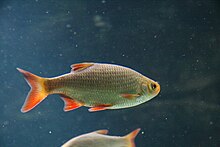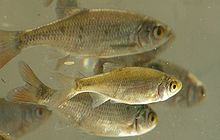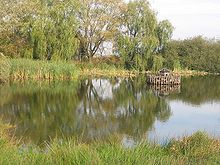Rudd
| Rudd | ||||||||||||
|---|---|---|---|---|---|---|---|---|---|---|---|---|

Rudd ( Scardinius erythrophthalmus ) |
||||||||||||
| Systematics | ||||||||||||
|
||||||||||||
| Scientific name | ||||||||||||
| Scardinius erythrophthalmus | ||||||||||||
| ( Linnaeus , 1758) |
The Rudd ( Scardinius erythrophthalmus ), also called spurious roach , red chalk or red lead is known, a species of fish family of carp fish .
features
The rudd has a size of 20–30 cm, up to a maximum of 50 cm, and a weight of 250 to 300 g. Very large specimens weigh a maximum of 2–3 kg. Rudds have a high back, laterally flattened body. The abdominal edge is keeled between the pelvic fins and anus . The front end of the dorsal fin lies clearly behind the attachment of the pelvic fin. The pectoral fins have 16–17 rays, the dorsal fin has 10–12 and the anal fin has 12–14 rays. The rudd has 40 to 43 large round scales along the sidelines. The back and top of the head are gray-green to brown-green in color. The flanks are lighter and shine in gold to brass colors. The iris of the eyes is also colored yellowish gold. The belly side is silver colored. The pelvic fins, anal and dorsal fin are orange to blood red, and brownish to gray at the base (Terofal 1984). The gold red feather or gold feather is a reddish-gold colored cultivated variety of the rudd. Large specimens weighing 2.5–3 kg are mostly hybrids , natural crosses with roach, bream or aland . A specimen weighing 1.58 kilograms is documented that was caught in the Ljungan River in Sweden in 1988 . Large rudd is caught not only in southern Sweden, but also in Denmark and Ireland .
Morphological differences between roach and rudd
The rudd is often confused with the roach ( Rutilus rutilus ), which belongs to the same family. The distinction is possible on the basis of the mouth: while the rudd has an upper mouth , that of the rudd is terminal. Another distinguishing feature is the fact that the dorsal fin begins behind the pelvic fins, in contrast to the roach, where these fins lie vertically on top of each other.
In addition to these notes, the fact that the roach between the ventral and anal fin has a rounded abdominal edge in contrast to the keeled abdominal edge of the rudd and that the eyes (often only identifiable in comparison) are really red in contrast to the golden yellow of the rudd is used to differentiate. Another feature is the number of scales in the sideline. If the roach has between 39 and 48, this is 40 to 42 for the rudd. Another, very similar fish is the Aland , which has significantly smaller scales (55 to 60) and a yellow eye circle.
Occurrence
The rudd occurs in Europe from the Urals , Caspian and Aral Sea to the Pyrenees . The northern limit of distribution is in Finland , the southern on the Tiber ( Italy ) and in North Macedonia . Isolated stocks also in Azerbaijan and Iran. The Danube region and Central Asia are regarded as the home and gene center of the rudd. In New Zealand rudd were introduced in the 1960s and have evolved there a nuisance, since they entered into direct competition for food with native fish species and altered native plant communities. The spread of the European rudd in Lake Hamilton transformed the macrophyte- dominated water into a phytoplankton dominated water. Similar phenomena were observed in Canada and Finland.
Ecological demands and way of life
The rudd is a schooling fish that can be found in standing (lakes, ponds, ponds) and slowly flowing waters with a soft, muddy bottom. Here it predominantly populates flat, soft ground and plant-rich areas. They can still be found in warm lakes up to an altitude of 900 m, in Switzerland up to a maximum of 1,800 meters. The preferred habitat in the summer months are heavily weed stretches of water and reed edges. Typical rudd habitats can be found, for example, in the lower reaches and delta of the Danish Gudenå, which are heavily overgrown with water lilies .
The adult , d. H. the adult rudd feed mainly on algae and aquatic plants ( spawning herbs , milfoil , waterweed, etc.) and to a lesser extent on invertebrates on the shore zone. The distribution of rudd is strongly linked to aquatic plants, on the one hand as cover, spawning substrate and food base. The roach feed mainly on duckweed , then her greenish feces can cloud the water. On the Volga , larger rudds sometimes even show predatory behavior and attack small fish at certain times of the year. Since rudd's need for oxygen is relatively low, they are able to colonize small, marginal waters together with crucian carp and tench .
During the spawning season (April - July) when the water temperature is around 18 ° C, the 2 to 3 year old animals flock to shallow, densely vegetated bank areas. This is where the sticky, about 1.5 mm large, conspicuous red-yellow eggs (100,000 - 200,000 / female) are laid on aquatic plants. Depending on the temperature, the larvae hatch after 3–10 days. Since the rudd often spawns together with other carp species , it occasionally hybridizes with other species.
Rudd are typical summer fish and have their main activity on warmer days in the months May to September , when they take in schools of approach food from the water surface. Rudd are most active in the early morning hours and at dusk. Rudd are extremely frightening and react to the smallest disturbance. Approaching predatory fish are tracked over the sideline, but in the event of wind and waves this " early warning system " is deactivated and pike, pikeperch and catfish can decimate schools of rudd.
During the winter months, the rudd visit the deeper water zones and greatly reduce their metabolism.
Hazard and protection
The rudd is listed by the International Union for Conservation of Nature ( IUCN) in the Red List of Endangered Species , but is currently rated as Least Concern .
It is counted as an endangered species by several states in the Federal Republic of Germany.
Genetically pure rudd trunks have become rare since hybridization with other species is quite common. Original genotypes have been preserved in the Shannon river system in Ireland.
Aquarium fish
Rudd can be kept relatively easily in cold water aquariums at temperatures of 10 to 20 ° C.
Economical meaning
Due to its very bone-rich meat, the rudd is of little importance as a food fish, with the exception of Eastern Europe , where like other white fish it is processed into fish cakes . Like the roach, it is regionally popular as a fishing fish due to its frequent occurrence and relatively easy catchability . Indigenous rudds are supposed to fight the waterweed at the Baldeneysee , which already overgrows 25% of the water. Rudds are able to consume approx. 25 g Elodea canadensis per day . Similar measures against Elodea nuttallii are planned in Toeppersee near Duisburg . Rudd rudd is one of the endangered fish species in North Rhine-Westphalia, so that this measure can create new stocks in a large body of water.
Greek rudd
A closely related species, the Greek rudd ( Scardinius graecus ), is endemic to some lakes (Yliki Lake, Para Lake) and lowland waters (Kifissos River) in southern Greece. In terms of habit, it is smaller and more elongated than the rudd, it usually only reaches a weight of 400 g with a maximum length of 40 cm. Very little is known about their way of life. The populations are currently threatened by water loss through drought, hydraulic engineering , environmental pollution and habitat destruction.
literature
- Emili García-Berthou, Ramón Moreno-Amich: Rudd (Scardinius erythrophthalmus) introduced to the Iberian peninsula feeding ecology in Lake Banyoles. Hydrobiologia, Springer Netherlands, 2004, pp. 159-164.
- J. Novák: Growth, abundance and production of the rudd (Scardinius erythrophthalmus) in some backwaters in the labe inundation region. Czechoslovakia (Pisces: Cyprinidae), 1982.
- Elisabeth Haberlehner: Comparative analysis of feeding and schooling behavior of the Cyprinidae Alburnus alburnus (L., 1758), Rutilus rutilus (L., 1758), and Scardinius erythrophthalmus (L., 1758) in a backwater of the Danube near Vienna. Limnological Institute, University of Vienna, Vienna, Austria 1988.
- N. Papageorgiou, C. Neophitou: Age, growth and fecundity of the rudd (Scardinius erythrophthalmus L.) in Lake Kastoria. Thalassographica 2 (5), 1982, pp. 5-15.
- K. Iliadou and Ontrias: Contribution in the biology of Scardinius erythrophthalmus of the Lakes Lysimachia and Trichonis of the western part of Greece. 1980.
- K. Iliadou, J. Sourdis, PS Economidis, A. Wheeler: Morphological differentiation among species of the genus Scardinius (Pisces: Cyprinidae) in Greece. Journal of Natural History, 1996, pp. 459-473.
- M. Kennedy, P. Fitzmaurice: Biology of the Rudd (Scardinius erythrophthalmus) in Irish waters. Royal Irish Academy, 1974.
Web links
- Rotfeder on Fishbase.org (English)
- Siegfried Blank: Rotfeder: more information and photos. In: Pisci Page. Retrieved March 7, 2010 .
Individual evidence
- ↑ Aqualog News No. 57 ( aqualog.de ( Memento of the original from May 19, 2014 in the Internet Archive ) Info: The archive link has been inserted automatically and has not yet been checked. Please check the original and archive link according to the instructions and then remove this note. PDF ).
- ↑ igfa.org
- ↑ isolated populations also in the arctic tributaries of the Dvina near Arkhangelsk in EI Boznák: The rudd Scardinius erythrophthalmus from tributaries of the Northern Dvina, Journal of Ichthyology, MAIK Nauka / Interperiodica distributed exclusively by Springer Science + Business Media LLC., 2008, p. 408-410
- ^ A b c Brian W. Coad: Freshwater Fishes of Iran
- ↑ Brendan J. Hicks: Biology and potential impacts of rudd (Scardinius erythrophthalmus L.) in New Zealand.
- ^ Ontario Freshwater Fishes Life History Database
- ↑ Leena Nurminen, Jukka Horppila: Effect of rudd herbivory on submerged macrophytes in a shallow eutrophic lake / International Conference on Limnology of Shallow Lakes. 2002.
- ↑ Rotfeder at the Austrian Board of Trustees for Fisheries and Water Protection (ÖKF) ( Memento of the original from May 19, 2014 in the Internet Archive ) Info: The archive link was inserted automatically and has not yet been checked. Please check the original and archive link according to the instructions and then remove this notice.
- ↑ Divine Mixture . In: blinker . No. 3 , March 2007, p. 28–33 ( konceptoriet.dk ( Memento from May 19, 2014 in the Internet Archive ) [PDF; accessed on May 4, 2016]). Divine mixture ( Memento of the original from May 19, 2014 in the Internet Archive ) Info: The archive link was inserted automatically and has not yet been checked. Please check the original and archive link according to the instructions and then remove this notice.
- ↑ a b fischerei-edersee.com
- ↑ blinker.de ( Memento of the original from December 23, 2012 in the Internet Archive ) Info: The archive link was inserted automatically and has not yet been checked. Please check the original and archive link according to the instructions and then remove this notice.
- ↑ ( Page no longer available , search in web archives: oekf.at )
- ↑ Scardinius erythrophthalmus in the endangered Red List species the IUCN 2009. Posted by: Freyhof, J. & Kottelat, M., 2008. Accessed March 7 of 2010.
- ↑ Online query of the rudd in the red list of endangered animals in Germany and its federal states. science4you, accessed March 7, 2010 .
- ↑ Alwyne Wheeler: On the populations of roach (Rutilus rutilus), rudd (Scardinius erythrophthalmus), and their hybriin Esthwaite Water, with notes on the distinctions between them. Department of Zoology, British Museum (Natural History), London, 1975.
- ↑ Rudd world-of-animals.de
- ↑ bild.de
- ↑ derwesten.de
- ↑ derwesten.de
- ^ Fishing World Records
- ↑ fishbase.sinica.edu.tw
- ↑ Scardinius graecus in the IUCN Red List of Threatened Species .


